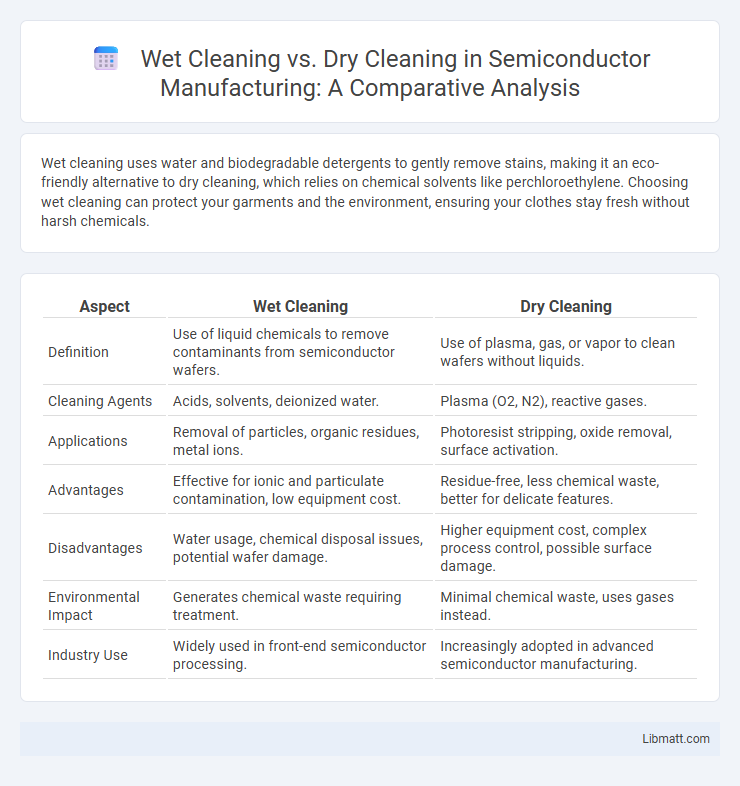Wet cleaning uses water and biodegradable detergents to gently remove stains, making it an eco-friendly alternative to dry cleaning, which relies on chemical solvents like perchloroethylene. Choosing wet cleaning can protect your garments and the environment, ensuring your clothes stay fresh without harsh chemicals.
Table of Comparison
| Aspect | Wet Cleaning | Dry Cleaning |
|---|---|---|
| Definition | Use of liquid chemicals to remove contaminants from semiconductor wafers. | Use of plasma, gas, or vapor to clean wafers without liquids. |
| Cleaning Agents | Acids, solvents, deionized water. | Plasma (O2, N2), reactive gases. |
| Applications | Removal of particles, organic residues, metal ions. | Photoresist stripping, oxide removal, surface activation. |
| Advantages | Effective for ionic and particulate contamination, low equipment cost. | Residue-free, less chemical waste, better for delicate features. |
| Disadvantages | Water usage, chemical disposal issues, potential wafer damage. | Higher equipment cost, complex process control, possible surface damage. |
| Environmental Impact | Generates chemical waste requiring treatment. | Minimal chemical waste, uses gases instead. |
| Industry Use | Widely used in front-end semiconductor processing. | Increasingly adopted in advanced semiconductor manufacturing. |
Introduction to Wet Cleaning and Dry Cleaning
Wet cleaning uses water and specialized detergents to safely and effectively clean delicate fabrics, making it an eco-friendly alternative to traditional methods. Dry cleaning involves solvents like perchloroethylene to remove stains without water, preserving fabric quality while preventing shrinkage and damage. Understanding these processes helps you choose the best cleaning method tailored to your garment's material and care requirements.
Understanding Wet Cleaning: Process and Benefits
Wet cleaning uses water and biodegradable detergents to clean delicate fabrics, avoiding harsh chemicals typical of dry cleaning. This eco-friendly process gently removes dirt and odors through controlled moisture, temperature, and mechanical action, preserving fabric integrity and extending garment lifespan. Its benefits include being safer for sensitive materials, reducing environmental impact, and minimizing health risks associated with chemical solvents like perchloroethylene.
How Dry Cleaning Works: Key Methods Explained
Dry cleaning uses chemical solvents, primarily perchloroethylene (perc), to remove stains and dirt from fabrics without water, preserving delicate materials like silk and wool. The process involves immersing garments in the solvent, which dissolves oils and grease, followed by centrifugation to extract the chemicals and impurities. Your clothes benefit from a gentle yet effective cleaning method that maintains fabric integrity and prevents shrinkage or damage common with traditional washing.
Fabric Compatibility: Which Method Suits Which Material?
Wet cleaning is ideal for natural fibers such as cotton, wool, and silk, as it gently uses water and mild detergents to preserve fabric integrity. Dry cleaning suits delicate or structured fabrics like silk, wool blends, and synthetics, preventing shrinkage and fiber distortion by using organic solvents instead of water. Choosing the appropriate method depends on fabric composition, care labels, and potential risks of water damage or chemical sensitivity.
Environmental Impact: Wet Cleaning vs Dry Cleaning
Wet cleaning uses water and biodegradable detergents, making it an eco-friendly alternative to traditional dry cleaning, which relies on perchloroethylene (perc), a toxic solvent harmful to air and water quality. Wet cleaning produces fewer hazardous emissions and reduces the risk of soil and groundwater contamination, supporting sustainable garment care practices. Consequently, wet cleaning is increasingly preferred by environmentally conscious consumers and businesses aiming to minimize their ecological footprint.
Effectiveness in Stain Removal
Wet cleaning uses water and biodegradable detergents, breaking down water-soluble stains like sweat and food more effectively than dry cleaning. Dry cleaning employs solvent-based methods, which excel at removing oil-based stains such as grease and ink without damaging delicate fabrics. Your choice depends on the type of stain and fabric sensitivity to ensure optimal stain removal.
Cost Comparison: Wet Cleaning vs Dry Cleaning
Wet cleaning generally costs less than dry cleaning due to its use of water and mild detergents instead of expensive solvents like perchloroethylene. Your garment care expenses can be reduced by choosing wet cleaning, especially for delicate fabrics that do not require solvent-based treatment. Dry cleaning typically involves higher operational costs, reflected in the price, because of specialized equipment and chemical handling requirements.
Garment Longevity and Care Tips
Wet cleaning uses water and specialized detergents that are gentler on fabrics, helping to preserve garment longevity by reducing shrinkage and fiber damage compared to harsh solvents used in dry cleaning. For optimal care, avoid frequent dry cleaning to prevent weakening fabric structure, and always follow garment care labels to maintain your clothes' appearance and durability. You can extend the life of delicate items by choosing wet cleaning for natural fibers like wool and silk, which retain texture and color better under this method.
Health and Allergen Considerations
Wet cleaning uses water and biodegradable detergents that effectively remove allergens like dust mites and pet dander without harsh chemicals, promoting better indoor air quality and skin health. Dry cleaning involves solvents such as perchloroethylene, which can cause respiratory irritation and exacerbate allergic reactions in sensitive individuals. Choosing wet cleaning reduces exposure to toxic chemicals, making it a safer option for people with allergies and respiratory conditions.
Choosing the Right Cleaning Method for Your Needs
Selecting the appropriate cleaning method depends on fabric type, garment construction, and stain sensitivity. Wet cleaning uses water and specialized detergents, ideal for delicate or natural fibers, while dry cleaning employs solvent-based processes suitable for synthetic or structured garments. Evaluating care labels and consulting professional cleaners ensures optimal fabric care and longevity.
Wet Cleaning vs Dry Cleaning Infographic

 libmatt.com
libmatt.com